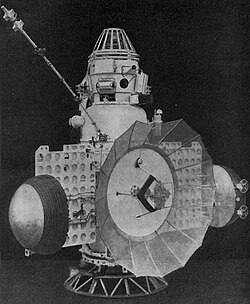Zond 2
 | |||||
| Status | misslyckad | ||||
|---|---|---|---|---|---|
| Organisation | Sovjetunionen | ||||
| NSSDC-ID | 1964-078C[1] | ||||
| Uppskjutning | |||||
| Uppskjutningsplats | Bajkonur | ||||
| Uppskjutning | 30 november 1964 | ||||
| Uppskjutningsfarkost | R-7 Semjorka | ||||
| Omloppsbana runt Solen | |||||
| Förbiflygning av Mars | |||||
| Datum | 6 augusti 1965 | ||||
| Minsta avstånd | 1 500 km | ||||
| Kronologi | |||||
| |||||
Zond 2 (ryska: Зонд-2) var en sovjetisk rymdsond i Zondprogrammet. Rymdsonden sköts upp den 30 november 1964, med en R-7 Semjorka raket. Farkosten missade Mars med 1 500 km.
Källor
- Den här artikeln är helt eller delvis baserad på material från engelskspråkiga Wikipedia, tidigare version.
Fotnoter
- ^ ”NASA Space Science Data Coordinated Archive” (på engelska). NASA. https://nssdc.gsfc.nasa.gov/nmc/spacecraft/display.action?id=1964-078C. Läst 28 mars 2020.
| ||||||||||||||||
Media som används på denna webbplats
L1 (Zond) circumlunar spacecraft.
Författare/Upphovsman: NASA on The Commons, Licens: No restrictions
(1965) Zond 2 was an automatic interplanetary station launched from a Tyazheliy Sputnik (64-078A) in Earth parking orbit towards Mars to test space-borne systems and to carry out scientific investigations. The probe carried a descent craft and the same instruments as the Mars 1 flyby spacecraft: a magnetometer probe, television photographic equipment, a spectroreflectometer , radiation sensors (gas-discharge and scintillation counters), a spectrograph to study ozone absorption bands, and a micrometeoroid instrument. The spacecraft had six experimental low-thrust electrojet plasma ion engines that served as actuators of the attitude control system and could be used instead of the gas engines to maintain orientation. Power was provided by two solar panels.
Zond 2 took a long curving trajectory towards Mars to minimize the relative velocity. The electronic ion engines were successfully tested shortly after launch under real space environment conditions over the period December 8-18, 1964. One of the two solar panels failed so only half the anticipated power was available to the spacecraft. After a mid-course maneuver, communications with the spacecraft were lost in early May, 1965. The spacecraft flew by Mars on 6 August 1965 at a distance of 1500 km and a relative speed of 5.62 km/s.
nasaimages.org/luna/servlet/detail/nasaNAS~20~20~120437~2...


